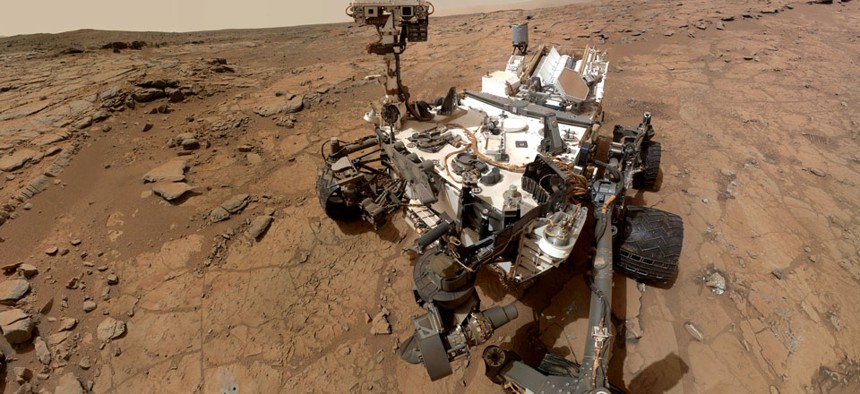Of Asteroids and ETs: How Cloud Innovation is Driving Space Exploration

A self-portrait taken by the NASA rover Curiosity in Gale Crater on Mars. NASA/AP
In just a few years, cloud computing could help aid the search for extraterrestrial life.
In the past eight years, cloud computing has evolved from the simple concept of renting computing power and storage into a nearly ubiquitous technology few individuals using a mobile device or Internet-connected computer could avoid even if they tried.
But in a few more years, cloud computing is poised to go even further, including aiding the search for extraterrestrial life.
If it sounds a little far-fetched, consider this: Scientists and engineers at NASA’s Jet Propulsion Laboratory currently run simulations in Amazon Web Services’ GovCloud that could decide whether its Asteroid Retrieval Mission receives budget funding or whether and how NASA might send an autonomous craft to Jupiter’s moon, Europa, to look for extraterrestrial life.
“All these things require very rapid prototyping, and that’s what cloud gives us,” Tom Soderstrom, NASA JPL’s chief technology officer, said in a presentation Wednesday at the AWS re:Invent conference in Las Vegas. “Cloud is an innovator accelerator. "
Soderstrom describes the current technology environment with the catchy acronym “SMACK,” which stands for social media, mobile, analytics, cloud and key disruptors.
For NASA and its research-intensive efforts, cloud computing stands out because of its potential to drive innovation.
Mars Rover Data Parsed in the Cloud
“The No. 1 thing for us to move so fast is cloud computing, and all the prep work we did getting ready for the cloud,” said Soderstrom, who helped drive NASA’s early cloud efforts as far back as 2007. “Especially for us, GovCloud is a safe playground, a safe place to experiment.”
Take, for example, the 240 million data points contained within the Mars Curiosity rover’s telemetry monitors. Real-time telemetry data feeds into JPL’s analytics cloud within GovCloud, which “lets people touch and interact with it and ask questions,” he said.
Missions can be adapted rapidly, and this copied data can’t affect back-end systems so it's extraordinarily valuable without posing unnecessary risks.
Cloud has paid steep financial dividends, too, Soderstrom said.
“Two years ago using AWS on Curiosity, we were over 100 times more cost effective than nine years earlier when we landed on Mars -- and we took in 10 times more data,” Soderstrom said. “What this is letting us do is create new things, infuse new capabilities into mission. We’ve done things we never could do before, and in minutes.”
Researchers at JPL can spin up virtual machines and run complex model-based engineering simulations, including those required to investigate how a craft might traverse the solar system, land on Europa, drill down through potentially miles of ice and then act as a submarine, seeking out signs of life.
This kind of model-based engineering wouldn’t be possible in traditional data centers, at least not without an unlimited budget.
But through GovCloud, Soderstrom said, machines can be provisioned and parameters can be changed. In fact, a single system administrator actually ran that model in a single weekend, Soderstrom said -- not months, as it would have taken through traditional data centers.
Next Mission: ‘Capture an Asteroid’
Researches and engineers now use the same techniques in cloud to assess how best to “capture an asteroid,” Soderstrom said.
“For these types of missions, cloud is a wonderful tool,” Soderstrom said. “You can save a ton of money, but also get long-term results.”
That base concept of cloud – that it's cheaper and more efficient to “pay as you go” or “pay-per-use” – has exploded into a $200 billion per year industry, with the federal government expected to spend some $8 billion annually on cloud by 2017.
And NASA, one of the earliest cloud adopters in government, is now but one of many users.
Even the risk-averse intelligence community has ponied up for cloud, with the CIA spending $600 million for a private cloud developed by Amazon Web Services and the National Security Agency beginning to move all its signals intelligence data into its open-source cloud.
NASA’s cloud efforts, just like the intelligence community’s, are driven not only by cost savings but also by the expanded potential for innovation.
And NASA’s message is clear: Sooner, rather than later, innovation is going to have significant ramifications for space exploration.
NEXT STORY: The iPhone Case That Can Call the Police






